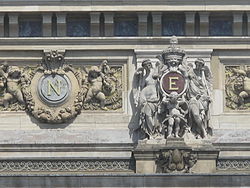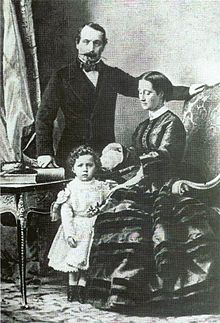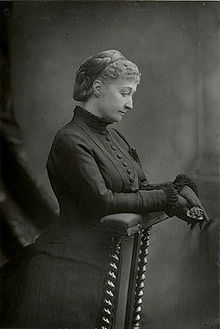- Empress Eugenie redirects here. For other uses of the term see Empress Eugenie (disambiguation)
| Eugénie de Montijo | |
|---|---|
| Countess of Teba and Marquise of Ardales | |
.jpg) | |
| The empress' official portrait | |
| | |
| Tenure | 30 January 1853 – 11 January 1871 |
| Spouse | Napoleon III of France |
| Issue | |
| Napoléon Eugène, Prince Imperial | |
| Full name | |
| María Eugenia Ignacia Augustina de Palafox Portocarrero de Guzmán y Kirkpatrick | |
| House | House of Bonaparte |
| Father | Cipriano de Palafox y Portocarrero |
| Mother | María Manuela Enriqueta Kirkpatrick de Closbourn y de Grevigné |
| Born | 5 May 1826 Granada, Spain |
| Died | 11 July 1920 (aged 94) Madrid, Spain |
| Burial | Saint Michael's Abbey, Farnborough |
| Signature | |
| Religion | Roman Catholicism |
Doña María Eugenia Ignacia Augustina de Palafox-Portocarrero de Guzmán y Kirkpatrick, 16th Countess of Teba and 15th Marquise of Ardales (5 May 1826 – 11 July 1920), known as Eugénie de Montijo (French: [øʒeni də montiʒo]), was the last Empress consort of the French from 1853 to 1871 as the wife of Napoleon III, Emperor of the French.
Empress

The last Empress of the French was born in Granada, Spain, to Don Cipriano de Palafox y Portocarrero (1785–1839), Grandee, whose titles included Count of Ablitas, 9th Count of Montijo, 15th Count of Teba, 8th Count of Fuentidueña, 14th Marquis of Ardales, 17th Marquess of Moya and 13th Marquis of la Algaba.[1] and his half-Scottish, quarter-Belgian, quarter-Spanish wife (whom he married on 15 December 1817), María Manuela Enriqueta Kirkpatrick de Closbourn y de Grevigné (24 February 1794 – 22 November 1879), a daughter of the Scots-born William Kirkpatrick of Closbourn (1764–1837), who became United States consul to Málaga, and later was a wholesale wine merchant, and his wife, Marie Françoise de Grevignée (born 1769), daughter of Liège-born Henri, Baron de Grevignée and wife Doña Francisca Antonia Gallegos (1751–1853).
Eugenia's older sister, María Francisca de Sales de Palafox Portocarrero y Kirkpatrick, nicknamed "Paca" (24 January 1825 – 16 September 1860), who inherited most of the family honours and was 12th Duchess of Peñaranda Grandee of Spain and 9th Countess of Montijo, title later ceded to her sister, married the Duke of Alba in 1849. Until her own marriage in 1853, Eugénie variously used the titles of Countess of Teba or Countess of Montijo, but some family titles were legally inherited by her elder sister, through which they passed to the House of Alba. After the death of her father, Eugenia became the 9th Countess of Teba, and is named as such in the Almanach de Gotha (1901 edition). After Eugenia's demise all titles of the Montijo family came to the Fitz-Jameses (the Dukes of Alba and Berwick).
Eugénie de Montijo, as she became known in France, was educated in Paris, at the fashionable Convent of the Sacré Cœur. When Prince Louis Napoléon became president of the Second Republic, she appeared with her mother at several balls given by the "prince-president" at the Elysée Palace; it was there that she met the future emperor, whom she wed on 30 January 1853. In a speech from the throne on 22 January, Napoleon III formally announced his engagement, saying, "I have preferred a woman whom I love and respect to a woman unknown to me, with whom an alliance would have had advantages mixed with sacrifices".[2]
The match was looked upon dubiously in the United Kingdom. The Times editorialized: "We learn with some amusement that this romantic event in the annals of the French Empire has called forth the strongest opposition, and provoked the utmost irritation. The Imperial family, the Council of Ministers, and even the lower coteries of the palace or its purlieus, all affect to regard this marriage as an amazing humiliation..."[citation needed]
On 16 March 1856, the empress gave birth to an only son, Napoléon Eugène Louis Jean Joseph Bonaparte, styled Prince Impérial. Her husband often consulted her on important questions, and she acted as Regent during his absences in 1859, 1865 and 1870. A Catholic and a conservative, her influence countered any liberal tendencies in the emperor's policies. She was a staunch defender of papal temporal powers in Italy and of ultramontanism. She was blamed for the fiasco of the French intervention in Mexico and the eventual death of Emperor Maximilian I of Mexico.[3]
According to events depicted in both the book and film The Song of Bernadette , Eugénie believed that her son had been miraculously cured from a fever after being sprinkled with water from the spring at Massabielle.
In 1868, Empress Eugénie visited the Dolmabahçe Palace in Constantinople, the home to Sultana Pertevniyal Sultan, mother of Abdülaziz, 32nd sultan of the Ottoman Empire. Pertevniyal became outraged by the forwardness of Eugénie taking the arm of one of her sons while he gave a tour of the palace garden, and she gave the Empress a slap on the stomach as a possibly more subtly intended than often represented reminder that they were not in France.[4]
After the Franco-Prussian War
When the Second French Empire was overthrown after France's defeat in the Franco-Prussian War (1870–71), the empress and her husband took refuge in England, and settled at Chislehurst, Kent. After his death in 1873, and that of her son in 1879, she moved in 1885 to Farnborough, Hampshire and to her villa "Cyrnos" (ancient Greek name of Corsica), which was built at Cape Martin, between Menton and Nice, where she lived in retirement, abstaining from politics. Her house in Farnborough is now an independent Roman Catholic girls' school, Farnborough Hill.[5]
After the deaths of her husband and son, as her health started to deteriorate, she spent some time at Osbourne House on the Isle of Wight; her physician recommended she visit Bournemouth which was, in Victorian times, famed as a health spa resort. During her afternoon visit in 1881, she called on the Queen of Sweden, at her residence 'Crag Head'.[6] Then aged 88, the Empress visited Portsmouth on the 6th of November 1914 to inspect the gunboat HMS Thistle fitting out there. [7] The former empress died in July 1920, aged 94, during a visit to her relatives, the Dukes of Alba in Madrid, in her native Spain, and she is interred in the Imperial Crypt at St Michael's Abbey, Farnborough, with her husband and her son, who had died in 1879 fighting in the Zulu War in South Africa. She left her possessions to various relatives: her Spanish estates went to the grandsons of her sister, the Fitz-Jameses (Dukes of Berwick and Alba), the house in Farnborough with all collections to the heir of her son, Prince Victor Bonaparte, Villa Cyrnos to his sister, Princess Laetitia of Aosta. Liquid assets were divided into three parts and given to the above relatives, except the sum of 100 000 francs bequeathed to the Committee for Rebuilding the Cathedral of Reims.[citation needed]
Her deposed family's friendly association with the United Kingdom was commemorated in 1887 when she became the godmother of Victoria Eugenie of Battenberg (1887–1969), daughter of Princess Beatrice, who later became Queen consort of Alfonso XIII of Spain. This baptism was an early example of ecumenism as Victoria Eugenie was baptised in the (Protestant) Church of Scotland.[citation needed]
Legacy

The Empress has also been commemorated in space; the asteroid 45 Eugenia was named after her,[8] and its moon, Petit-Prince, after the Prince Imperial.[9]
She had an extensive and unique jewelry collection, most of them were later owned by the Brazilian socialite Aimée de Heeren. [10][11] De Heeren collected jewelry and was fond of the Empress as both were considered to be the "Queens of Biarritz"; both would spend summers on the Côte Basque.Impressed by the elegance, style and design of the Jewellery of the neo classical era, in 1858 she had a boutique in the Royal Palace under the name ‘Royale Collection’.
She was honoured by John Gould who named the White-headed Fruit Dove Ptilinopus eugeniae
In popular culture
Named for the Empress, the Eugénie hat is a style of women's chapeau worn dramatically tilted and drooped over one eye; its brim is folded up sharply at both sides in the style of a riding topper, often with one long ostrich plume streaming behind it.[12] The hat was popularized by film star Greta Garbo and enjoyed a vogue in the 1930s that was "hysterically popular".[13] More redolent of the Empress' actual apparel, however, was the late nineteenth-century fashion of the Eugénie paletot, a women's greatcoat with bell sleeves and a single button enclosure at the neck.[14]
Titles from birth to death
- Doña María Eugenia Ignacia Augustina Palafox de Guzmán Portocarrero y Kirkpatrick (May 5, 1826, from birth until her father's death)
- Her Excellency Doña María Eugenia Ignacia Augustina Palafox de Guzmán Portocarrero y Kirkpatrick, 19th Countess of Teba (1839, from her father's death till her wedding)
- Her Imperial Majesty The Empress of the French (1853–1870) as well as Her Imperial Majesty The Empress-Regent during several periods (including the Italian, Crimean and Franco-Prussian wars)
- Her Imperial Majesty Empress Eugénie of France (1870–1920)
Honours
- 475th Dame of the Royal Order of Queen María Luisa of Spain
- Honorary Dame Grand Cross of the Order of the British Empire (Hon. GBE)
- Grand Cross of the Order of Saint Charles (Mexico)
Ancestry
| Ancestors of Eugénie de Montijo | ||||||||||||||||||||||||||||||||||||||||||||||||||||||||||||||||||||||||||||||||||||||||||||||||||||||||||||||||||||||||||||||||||||||||||||||||||||||||||||||||||||||||||||||||||||||||||||||||||||||||||||||||||||||||||||||||||||||||||||||||||||||||||||||||||||||||||||||||||||||||||||||||||||||||||||||||||||||||||||||||||||||||||||||||||||||||||||||||||||||||||||||||||||||||||||||||||||||||||||||||||||||||||||||||||||||||||||||||||||||||||||||||||||||||||||||||||||||||||||||||||||||||||||||||||||||||||||||||||||||||||||||||||
|---|---|---|---|---|---|---|---|---|---|---|---|---|---|---|---|---|---|---|---|---|---|---|---|---|---|---|---|---|---|---|---|---|---|---|---|---|---|---|---|---|---|---|---|---|---|---|---|---|---|---|---|---|---|---|---|---|---|---|---|---|---|---|---|---|---|---|---|---|---|---|---|---|---|---|---|---|---|---|---|---|---|---|---|---|---|---|---|---|---|---|---|---|---|---|---|---|---|---|---|---|---|---|---|---|---|---|---|---|---|---|---|---|---|---|---|---|---|---|---|---|---|---|---|---|---|---|---|---|---|---|---|---|---|---|---|---|---|---|---|---|---|---|---|---|---|---|---|---|---|---|---|---|---|---|---|---|---|---|---|---|---|---|---|---|---|---|---|---|---|---|---|---|---|---|---|---|---|---|---|---|---|---|---|---|---|---|---|---|---|---|---|---|---|---|---|---|---|---|---|---|---|---|---|---|---|---|---|---|---|---|---|---|---|---|---|---|---|---|---|---|---|---|---|---|---|---|---|---|---|---|---|---|---|---|---|---|---|---|---|---|---|---|---|---|---|---|---|---|---|---|---|---|---|---|---|---|---|---|---|---|---|---|---|---|---|---|---|---|---|---|---|---|---|---|---|---|---|---|---|---|---|---|---|---|---|---|---|---|---|---|---|---|---|---|---|---|---|---|---|---|---|---|---|---|---|---|---|---|---|---|---|---|---|---|---|---|---|---|---|---|---|---|---|---|---|---|---|---|---|---|---|---|---|---|---|---|---|---|---|---|---|---|---|---|---|---|---|---|---|---|---|---|---|---|---|---|---|---|---|---|---|---|---|---|---|---|---|---|---|---|---|---|---|---|---|---|---|---|---|---|---|---|---|---|---|---|---|---|---|---|---|---|---|---|---|---|---|---|---|---|---|---|---|---|---|---|---|---|---|---|---|---|---|---|---|---|---|---|---|---|---|---|---|---|---|---|---|---|---|---|---|---|---|---|---|---|---|---|---|---|---|---|---|---|---|---|---|---|---|---|---|---|---|---|---|---|---|---|---|---|---|---|---|---|---|---|---|---|---|---|---|---|---|---|---|---|---|---|---|---|---|---|---|---|---|---|---|---|---|---|---|---|---|---|---|---|---|---|---|---|---|---|---|---|---|---|---|---|---|---|---|---|---|---|---|---|---|---|---|---|---|---|---|---|---|---|---|---|---|---|
| ||||||||||||||||||||||||||||||||||||||||||||||||||||||||||||||||||||||||||||||||||||||||||||||||||||||||||||||||||||||||||||||||||||||||||||||||||||||||||||||||||||||||||||||||||||||||||||||||||||||||||||||||||||||||||||||||||||||||||||||||||||||||||||||||||||||||||||||||||||||||||||||||||||||||||||||||||||||||||||||||||||||||||||||||||||||||||||||||||||||||||||||||||||||||||||||||||||||||||||||||||||||||||||||||||||||||||||||||||||||||||||||||||||||||||||||||||||||||||||||||||||||||||||||||||||||||||||||||||||||||||||||||||
Film portrayals
- In Suez (1938): Loretta Young plays her as the love interest of Ferdinand de Lesseps.
- In Juarez (1939): Played by Gale Sondergaard, where she joins her husband in setting Austrian Archduke Maximilian on the throne of Mexico, and then abandoning him.
- In Violet Imperiales (1932, 1952): Set in Granada, 19th century Spain, Eugénie de Montijo (played by Simon Valérie) asks a gypsy girl, Violetta (played by Carmen Sevilla), to read her fortune in her hand. Emboldened by Violetta's prediction that she is to become a queen, Eugénie heads for Paris.
- In The Song of Bernadette (1943): Played by Patricia Morison; she credits the waters of Lourdes with curing the Prince Imperial.
- In The Diving Bell and the Butterfly (2007): Emma de Caunes plays her during a fantasy sequence.
- Miniseries Sisi (2009): Portrayed by Hungarian actress Andrea Osvart.
See also
- Eugénie Archipelago
References
Citations
- ^ Genealogy of the Counts of Montijo website
- ^ Kurtz 1964, p. 50.
- ^ Maximilian and Carlota by Gene Smith, ISBN 0-245-52418-5, ISBN 978-0-245-52418-9
- ^ Duff 1978, p. 191.
- ^ Farnborough Hill school website
- ^ Bournemouth Visitors Directory 2 February 1881
- ^ Log of HMS Thistle
- ^ Schmadel, Lutz D.; International Astronomical Union (2003). Dictionary of minor planet names. Berlin; New York: Springer-Verlag. p. 19. ISBN 978-3-540-00238-3. Retrieved 18 September 2011.
- ^ "Solar System Exploration: Asteroids – Moons". National Aeronautics and Space Administration. 2011. Retrieved 18 September 2011.
- ^ The Marguerite Necklace of Empress Eugenie and Aimee de Heeren
- ^ Aimee de Heeren wearing the Marguerite Necklace
- ^ Calasibetta, Charlotte Mankey; Tortora, Phyllis (2010). The Fairchild Dictionary of Fashion. New York: Fairchild Books. pp. 249–250. ISBN 978-1-56367-973-5. Retrieved 2011-09-18.
- ^ Shields, Jody (1991). Hats: A Stylish History and Collector's Guide. New York: Clarkson Potter. p. 43. ISBN 978-0-517-57439-3.
- ^ Calasibetta, p. 93.
External links
| Eugénie de Montijo Born: 5 May 1826 Died: 11 July 1920 | ||
| French royalty | ||
|---|---|---|
| Vacant Title last held by Marie Amalie of the Two Siciliesas Queen of the French | Empress of the French 30 January 1853–11 January 1871 | Monarchy abolished |
| Titles in pretence | ||
| Vacant Title last held by Marie Louise of Austria | — TITULAR — Empress of the French 11 January 1871 – 9 January 1873 Reason for succession failure: Empire replaced by Republic | Vacant Title next held by Clémentine of Belgium |
| Spanish nobility | ||
| Preceded by Cipriano de Palafox y Portocarrero | Countess of Teba 1839-1920 | Succeeded by Eugenia María Fitz-James Stuart |
| Marquise of Ardales 1839-1920 | Succeeded by Jacobo Fitz-James Stuart | |
| ||||||||
|

